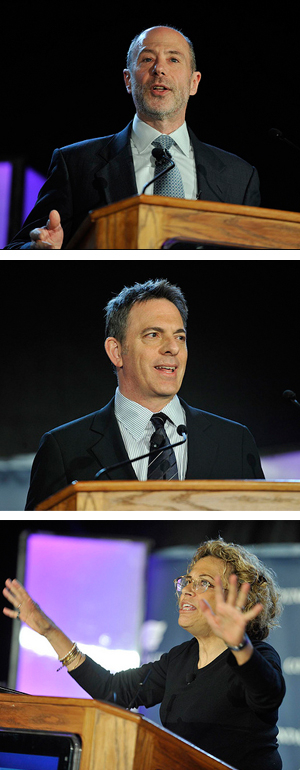Opening Plenary: Are You Meeting the Challenges of Todayís Philanthropy?
Sunday, April 10 - 11:30 a.m.-1 p.m.
Speakers Challenge Foundations to Speak Clearly, Leverage Their Investments, End Poverty
 Three inspirational speakers energized attendees at the opening session of the Council's annual conference, each addressing the question: Are you using all the tools at your disposal to accomplish your philanthropic mission and thrive in today's challenging environment?
Three inspirational speakers energized attendees at the opening session of the Council's annual conference, each addressing the question: Are you using all the tools at your disposal to accomplish your philanthropic mission and thrive in today's challenging environment?
Writer and communications consultant Tony Proscio flashed several tangled passages from grantmakers' literature to show the audience how language can cloud our thinking. "Jargon is not a problem of words that can't be understood but of words that have gone dry," he said. "What do these people DO?" he asked, pointing to the impenetrable prose on the screen.
But the issue is not about our vocabulary, he said. Rather, it's about what we're focusing on. We can't afford to drift away from the people whose lives we affect. Proscio urged listeners to heed the credo he learned from a board member who stopped him short during a presentation. Frustrated by his obfuscation, she asked abruptly, "Who's going to do what to whom for how much?"
We must remember, Proscio said, that foundations exist to make things happen, not just to give money away.
Pioneering social entrepreneur Dan Pallotta followed with a charge to attendees to use their financial wherewithal to give rise to new levels of civic engagement. He urged the philanthropic world to take the next step from venture philanthropy to a new "venture fundraising movement."
How do we do that? Foundations should invest in fundraising, not in programs. Pallotta cited a multiplier effect from the initial $50,000 investment in the California AIDS rides. Many similar events have attracted enthusiastic support through the years and grossed hundreds of millions of dollarsówhich in turn funds many worthy programs. "Find the program," he stressed. "Fund the fundraising." Programs lack the potential of the multiplier effect.
Educator Claire Gaudiani made an impassioned plea for philanthropy to solve poverty. "Our nation right now needs you to give it an aspiration to capture everyone's imagination," she said. Poverty is locking the bottom 15 percent of U.S. citizens out of life, liberty, and the pursuit of happiness.
She took the audience back to 1926, 150 years after the signing of the Declaration of Independence, when the nation was emerging from World War I. For the first time ever, the philanthropist Olivia Slocum Sage set in motion a series of surveys to document the lives of the country's poorest citizens. And the president of Sears Roebuck, Julius Rosenwald, saw poverty in the rural South and established matching grants that led to 5,357 new schools. He saw that advancing social justice would advance business and the economic condition of the nation.
Fast forward to 2026, 250 years after the Declaration. What will we have done, Gaudiani asked, to make us feel pride in our accomplishments? We will have reduced the incidence of Alzheimer's by 30 percent. AIDS and breast cancer will have become chronic not fatal diseases.
Foundations have funded the research that ended polio and other diseases, Gaudiani said, andówith a national commitment by the philanthropic worldówe can do anything we decide to do. "Government is not where innovation comes from. It comes from the foundation world," she explained.
